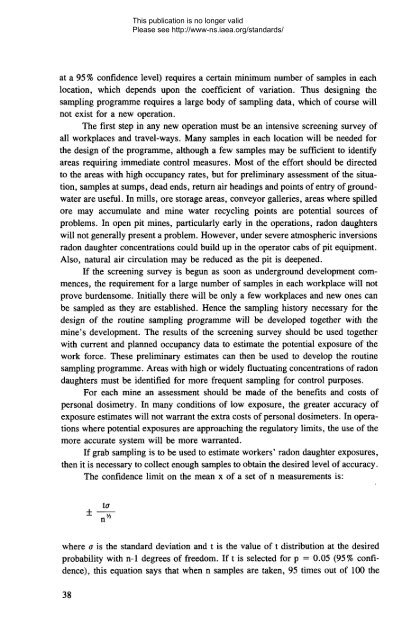IAEA SAFETY GUIDES - gnssn - International Atomic Energy Agency
IAEA SAFETY GUIDES - gnssn - International Atomic Energy Agency
IAEA SAFETY GUIDES - gnssn - International Atomic Energy Agency
Create successful ePaper yourself
Turn your PDF publications into a flip-book with our unique Google optimized e-Paper software.
This publication is no longer validPlease see http://www-ns.iaea.org/standards/at a 95 % confidence level) requires a certain minimum number of samples in eachlocation, which depends upon the coefficient of variation. Thus designing thesampling programme requires a large body of sampling data, which of course willnot exist for a new operation.The first step in any new operation must be an intensive screening survey ofall workplaces and travel-ways. Many samples in each location will be needed forthe design of the programme, although a few samples may be sufficient to identifyareas requiring immediate control measures. Most of the effort should be directedto the areas with high occupancy rates, but for preliminary assessment of the situation,samples at sumps, dead ends, return air headings and points of entry of groundwaterare useful. In mills, ore storage areas, conveyor galleries, areas where spilledore may accumulate and mine water recycling points are potential sources ofproblems. In open pit mines, particularly early in the operations, radon daughterswill not generally present a problem. However, under severe atmospheric inversionsradon daughter concentrations could build up in the operator cabs of pit equipment.Also, natural air circulation may be reduced as the pit is deepened.If the screening survey is begun as soon as underground development commences,the requirement for a large number of samples in each workplace will notprove burdensome. Initially there will be only a few workplaces and new ones canbe sampled as they are established. Hence the sampling history necessary for thedesign of the routine sampling programme will be developed together with themine’s development. The results of the screening survey should be used togetherwith current and planned occupancy data to estimate the potential exposure of thework force. These preliminary estimates can then be used to develop the routinesampling programme. Areas with high or widely fluctuating concentrations of radondaughters must be identified for more frequent sampling for control purposes.For each mine an assessment should be made of the benefits and costs ofpersonal dosimetry. In many conditions of low exposure, the greater accuracy ofexposure estimates will not warrant the extra costs of personal dosimeters. In operationswhere potential exposures are approaching the regulatory limits, the use of themore accurate system will be more warranted.If grab sampling is to be used to estimate workers’ radon daughter exposures,then it is necessary to collect enough samples to obtain the desired level of accuracy.The confidence limit on the mean x of a set of n measurements is:t awhere a is the standard deviation and t is the value of t distribution at the desiredprobability with n-1 degrees of freedom. If t is selected for p = 0.05 (95% confidence),this equation says that when n samples are taken, 95 times out of 100 the38
















